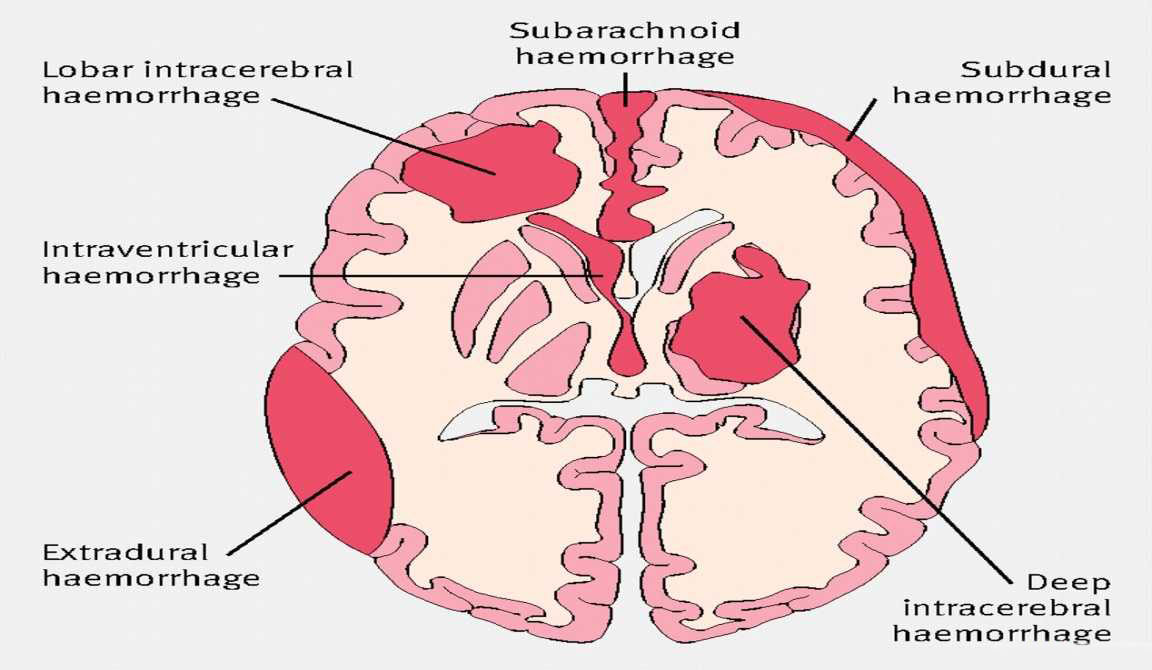Intracranial Hemorrhage is bleeding inside the skull. It is also called Intracranial Hematoma or Intracranial Bleeding. Depending on the type, location and size of the bleeding , a patient could be managed conservatively or treated aggressively with surgery. So what are the things you must know regarding Intracranial Hemorrhage?
1. What is the cause of the Intracranial Hematoma?
Bleeding inside the skull could be caused by several things.
- The most common would be that of head trauma.
- Another leading cause of would be due to uncontrolled hypertension, resulting into hemorrhagic stroke.
- Rupture of blood vessels in the case of Aneurysms and Arterio-Venous Malformations (AVM)
- Bleeding due to over anti-coagulation, usually seen in patients with heart disease whose dose of medications are unchecked.
- Bleeding disorders like Hemophilia, von Willebrand disease and dengue
- Brain tumor that bleeds
- Premature babies with fragile blood vessels that bleed causing Intraventricular Hemorrhage
2. Is the Hematoma inside the brain?
Bleeding could be found
A. Inside the skull, but Outside the brain ( Extra-axial hemorrhage), examples of which are the following:
- Epidural Hematoma
- Subdural Hematoma
- Subarachnoid Hemorrhage
B. Inside the skull, but Inside the brain (Intra-axial hemorrhage), examples of which are the following:
- Intracerebral Hemorrhage
- Intraventricular Hemorrhage
C. In both Extra-axial and Intra-axial hemorrhage
3. What type of Intracranial Bleeding is it?
Epidural Hematoma (EDH)
In this type of bleeding, the blood is found between the skull and the covering of the brain (Dura Mater).
On CT scan, the bleeding has a Bi-convex appearance.
Epidural Hematomas are usually due to Head Trauma.
Read more about Epidural Hematoma

Subdural Hematoma
In this type of bleeding, the blood is found between the covering of the brain (Dura Mater) and the underlying brain.
On CT scan, the bleeding has concave appearance or crescentic shape.
Subdural Hematomas are also usually due to Head Trauma.
Read more about Subdural Hematoma

Subarachnoid Hemorrhage (SAH)
In this type of bleeding, the blood is found in the subarachnoid space. The space in between the brain gyri.
On CT scan, the bleeding is found in the sulci and cisterns. In this example, it looks like a star.
Subarachnoid Hemorrhage is commonly due to head trauma but also seen in ruptured aneurysm cases.
Read more about Subarachnoid Hemorrhage

Intracerebral Hemorrhage
In this type of bleeding, the blood is found within the brain parenchyma.
On CT scan, the bleeding is found in the right basal ganglia, the usual location for hypertensive hemorrhagic stroke
Read more about Intracerebral Hemorrhage

Intraventricular Hemorrhage
In this type of bleeding, the blood is found in the Ventricles of the brain.
On CT scan, the bleeding is found inside the lateral ventricle.
Blood inside the ventricles has the potential of obstructing the CSF flow and cause sudden deterioration of the patient.
Read more about Intraventricular Hemorrhage


4. In which compartment is the bleeding found?
The brain could be divided into 2 major compartment. The supra tentorial compartment and the infra tentorial compartment. Neurologists and Neurosurgeons are more concerned on bleeding in the Infra-tentorial compartment or the Posterior fossa compartment. The reason for this concern, is that, the posterior fossa has a very limited space. If a significant amount of blood forms in this area, it will compress the surrounding brain. The structure we are most concerned about is the brainstem. The brainstem is the most important part of the brain since it controls the functions needed for life support.
5. How big is the Intracranial Hemorrhage?
Guidelines indicate that the threshold volume for surgery in the Supra-tentorial space is 30cc. For the infra tentorial space, the threshold volume is about 15cc.
Personally, I do not offer surgery solely on hematoma volume alone. I look at the patient holistically. I take into account patients current neurologic sensorium, age, co-morbidity, and potential to deteriorate.
6. How extensive is the brain edema?
The brain swells when it is injured. Aside from the volume of the blood clot, the extent of the brain edema is also being considered. There are cases, wherein there is very minimal bleeding but there is extensive brain swelling causing increased intracranial pressure.
7. Is the CSF pathway obstructed?
The Cerebro Spinal Fluid Pathway may become obstructed by the hematoma directly of indirectly. If bleeding extended into the ventricles (Intraventricular Hemorrhage) , the hematoma may directly obstruct the CSF flow by not allowing the CSF to pass through. The hematoma may also indirectly cause the obstruction, by pushing brain structures adjacent to the CSF pathway, making them compress the ventricles and inhibiting CSF flow.
If CSF could not properly pass through, it would accumulate in the ventricles and subsequently increase the intracranial pressure and cause brain herniation. Once the brain stem is compressed by the brain herniation, life support functions are compromised.
8. What is the condition of the patient?
A patient’s sensorium directly correlate to the severity of brain injury. We assess the patients sensorium / wakefulness and based on this, give a prognosis on chances of survival / functional outcome. It is not as simple as awake, comatose, or brain dead. A patient’s sensorium has a spectrum or range. In trauma, we use mild, moderate and severe brain injury based on a the patient’s sensorium.
9. When did the bleeding occur?
There are times when a neurosurgeon would recommend surgery even if the patient is wide awake. The reason for this is that, given a significant amount of blood, it would cause significant edema also. This edema will be the cause for a patient to deteriorate. The edema follows a bell curve, maximal edema occurs on the 4th to 7th day post injury/ictus.
10. Is a neurosurgeon available?
Not all hospitals are capable of handling Neurosurgical Cases. There are some hospitals where there is not even one Neurosurgeon in its roster. Intervention and management is compromised. If that is the case, feel free to reach out and let me help.
